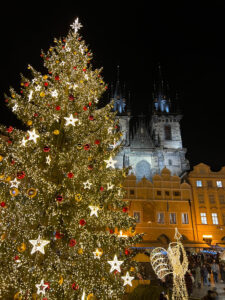
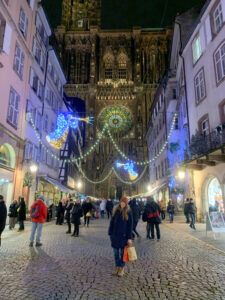
Since practically August, I’ve seen hundreds of reels, blog posts, and magazine articles listing what the writer assures us are the “Best” Christmas markets in Europe. How do they come up with these lists? There are hundreds (HUNDREDS) of Christmas markets throughout Europe, and each of those markets is someone’s favorite.
So if there aren’t objective “best” markets, how do you decide which of the hundreds to go to? I planned my Christmas Market route based on geography/transportation ease, cities I wanted to visit in the winter, size of the markets, and the market settings. I wished I could have visited some small-town markets, but because of our time constraints, I stuck with markets in larger cities where public transportation was more convenient. I wanted to see some of the most famous and historic markets alongside a few more obscure ones.
I ended up visiting around 20 markets across 7 cities. (It’s hard to count an exact number because many city markets blend together so you can’t tell where one ends and another begins.) And that is a hundred markets less than I’d need to visit to tell you with authority which ones are “best.” But of the ones I’ve visited, I can tell you my favorites.
Vienna, Austria – Wiener Christkindlemarkt on Rathausplatz
This was the first large Christmas market I visited in Europe, and it was as spectacular as I hoped. The market sits in front of the city hall—a stunning backdrop that looks far more like a Gothic palace than any “city hall” I’ve ever seen. They also have a giant, mystical double-decker carousel that looks like it was lifted from a fairy tale. Alongside the market, there’s a small section of fairground rides for kids, including a pretty Ferris wheel and a little ice-skating rink.
There are around 150 stalls at the market, full of ornaments, crafts, and toys. And the food selection here was fantastic. They had a lot of international food booths so you could try snacks from different cultures. (My mom and I got carried away at the arancini booth.) It was an excellent introduction to what a traditional Christmas market is like.
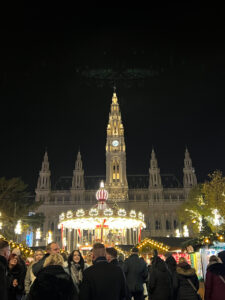
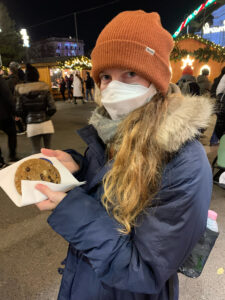

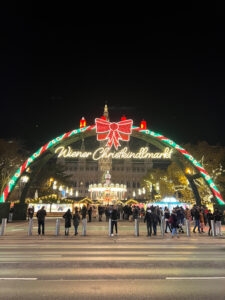
Prague, Czech Republic – Old Town Square Christmas Market
Prague’s Old Town Square is stunning in all seasons, but it is absolute magic during the holidays. In the middle of the market, you’re surrounded on all sides by historical buildings in a remarkable mix of vibrant colors and architectural styles (Gothic, Renaissance, Baroque, Rococo, Art Nouveau—a whole art history’s class worth of subject matter!) that makes the cityscape of Prague so beautiful. A giant Christmas tree stands in the center of the square, and over 100 market stalls surround it. Horses pull carriages over the cobbled streets, and it smells like every delicious holiday snack you’ve ever tasted. If Disney created a fantastical Christmas market, it would surely look like Prague’s.
The Old Town Market is full of tons of local food. There were booths selling svařák (Prague’s version of mulled wine), grog (a rum, lemon, and sugar drink), hot chocolate, tredelnik (chimney cakes), and more types of gingerbread than you can imagine. Smoke rises from the cottages as they roast meats and fry potatoes in the stalls. The food actually stood out to me a little more in this market than the shopping stalls did, but there were many lovely art stalls with paintings, home décor, and ornaments.
I visited Prague a bit early in the holiday season, so the Wenceslas Square Market wasn’t quite set up yet, but I’ve heard that this market is also fantastic. It’s just a couple minutes-walk from the Old Town Square, so the two sort of bleed into one another. It’s nearly as large as the Old Town Square Market, and I hear they have a petting zoo!
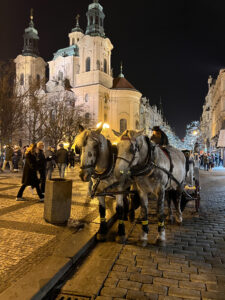
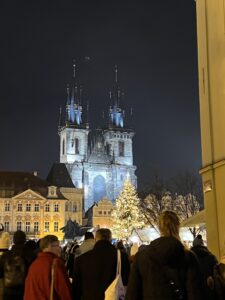
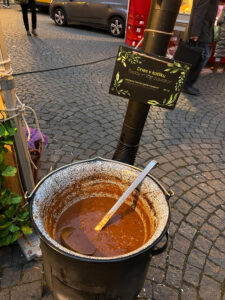

Munich, Germany – The Märchenbazar (Fairy Tale Bazaar)
This is undoubtedly the most unique market on this list, and the most obscure. Rather than a traditional Christmas market, this is more of an alternative, Bohemian, quasi-steampunk fair that takes places amongst a series of circus tents. In the tents, you can hear live music every night, and there are fairytales and theatrical performances for the kids. It’s called the Fairytale Bazaar, but it doesn’t have as much of a fairytale vibe as it does an eclectic, bohemian circus vibe. (It feels like it would fit right in where I live in New Orleans, and I don’t know why my aerial circus friends and I aren’t starting our own version right now.)
The market has a very international feel, and the dozens of food booths feature meals from Africa, Japan, Vietnam, and India. There are vegan options and a big focus on organic and handmade arts and crafts. It’s not hard to get to, but it is off the main tourist path, so you’ll avoid the massive tourist crowds. If you want to see something entirely unique to break up the more traditional markets that start to blur together after a while, this is a really special place.


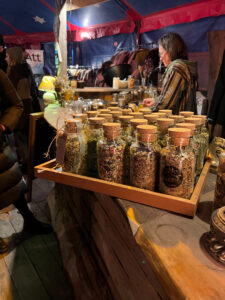

Salzburg, Austria – Salzburg Christkindlmarkt at Residenzplatz
Though I was not enamored with the city of Salzburg, I absolutely loved its main Christmas market. Perhaps because Salzburg is not as large as Vienna or Prague, the stalls felt a bit more authentic and local, and I did the most shopping here. This market contains about 100 stalls and sits mostly in the large Cathedral Square and area right next to it. There were tons of stalls with wool clothing, handmade crafts, toys, décor, and local foods and desserts. Because it’s contained in a smaller space than the large markets in Prague, Vienna, and Munich, it felt cozier.
There’s a large stage with choirs, drummers, and other musicians performing throughout the day. There was also a large ice-skating rink where I exhibited my grace and skill by scooting around the ice while holding onto a plastic animal with handlebars for balance.
This is also the market where the Krampus Run took place on Krampus Night. I wanted to be in a city with a popular Krampus Run but not one so massive that it would feel like Mardi Gras and where I wouldn’t be able to see over the crowds. This was exactly the right size and environment, and I couldn’t recommend it more.
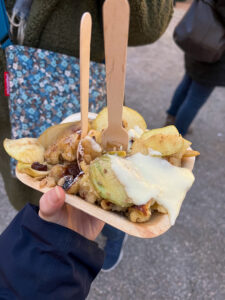
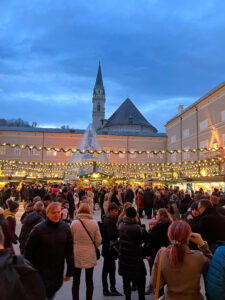

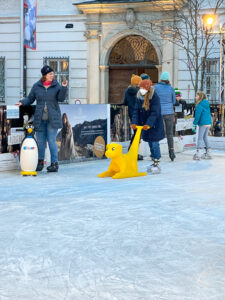
Strasbourg, France—the whole city
Strasbourg is sometimes called the Capital of Christmas, and it absolutely should be. Technically the Old Town houses about a dozen different Christmas Markets, but you truly can’t tell where each one ends and another begins, so I’m just grouping them all together. The city is small enough that you can wander around them all in a day or two. You practically can’t turn down a street in the Old Town without running into a new market section—the entire city transforms into this fairytale village. And somehow, due to some magic that I can’t understand, it doesn’t feel commercialized or tacky. It doesn’t feel manufactured at all. It just feels like you’ve stumbled into an otherworldly place full of people who are thrilled to welcome you and celebrate the season as exuberantly as possible.
The Christmas Market tradition in Strasbourg dates back to 1570 making it one of the oldest in Europe. The gargantuan Strasbourg Cathedral overlooks market stalls, a pretty carousel, and storefronts and restaurants that decorate just as enthusiastically as the market vendors. Inside the church, you can see a massive hand-crafted nativity scene. (The pieces aren’t massive—it sits on a table and extends practically the length of the building.)
In Place Kleber, you can see the tallest Christmas trees in all of Europe. (Specifically, it’s the tallest decorated natural tree in Europe. It’s about 100 feet tall.) You can watch the lighting of it every night, which I thought would be just… turning the lights on. But no—it’s a whole lightshow where the lights are choreographed to music for like 10 minutes. In the Petit France market, you can find all sorts of local snacks, cookies, and chocolates. The city has over 300 market stalls, and Christmas lights cover practically every inch of it. Staying in the city feels like an immersive Christmas experience rather than an event you go to and then leave.
I think if a person wants to go to Europe to have the most epic Christmas market experience and they don’t plan to do a lot of non-Christmas related sightseeing, this market is my top recommendation. I could spend the entire Christmas season here. (To be clear, Strasbourg is pretty magical at ALL times of the year—not just at Christmas.)

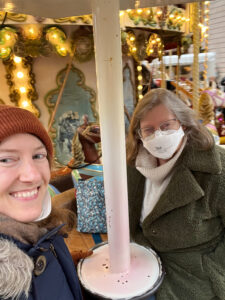

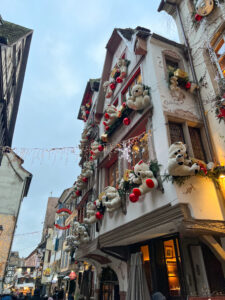
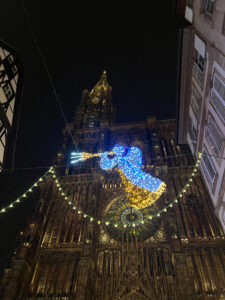

There are so many Christmas markets I’d love to visit. I’d love to visit some of the markets in the towns surrounding Strasbourg like Colmar. I’d love to spend time visiting tons of the German Christmas markets (both the large, famous ones like Nuremberg and some in small towns). I’d love to visit Polish markets in Wroclaw and Krakow. Bruges markets look beautiful. And I’d love to visit several of the markets in Eastern Europe like Budapest, Tallin, Zagreb, and Sibiu. No matter where you choose, I don’t think you can really go wrong.
I’d love to hear what your favorite markets are!
